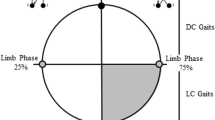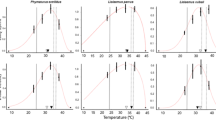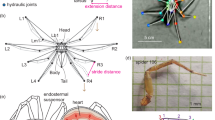Abstract
Gliding allows mammals to exploit canopy habitats of old-growth forests possibly as a means to save energy. To assess costs of quadrupedal locomotion for a gliding arboreal mammal, we used open-flow respirometry and a variable-speed treadmill to measure oxygen consumption and to calculate cost of transport, excess exercise oxygen consumption, and excess post-exercise oxygen consumption for nine northern flying squirrels (Glaucomys sabrinus) and four fox squirrels (Sciurus niger). Our results indicate that oxygen consumption during exercise by flying squirrels was 1.26–1.65 times higher than predicted based on body mass, and exponentially increased with velocity (from 0.84 ± 0.03 ml O2 kg−1 s−1 at 0.40 m s−1 to 1.55 ± 0.03 ml O2 kg−1 s−1 at 0.67 m s−1). Also, cost of transport in flying squirrels increased with velocity, although excess exercise oxygen consumption and excess post-exercise oxygen consumption did not. In contrast, oxygen consumption during exercise for fox squirrels was similar to predicted, varying from 0.51 (±0.02) ml O2 kg−1 s−1 at 0.63 m s−1 to 0.54 (±0.03) ml O2 kg−1 s−1 at 1.25 m s−1. In addition, the cost of transport for fox squirrels decreased with velocity, while excess exercise oxygen consumption and excess post-exercise oxygen consumption did not. Collectively, these observations suggest that unlike fox squirrels, flying squirrels are poorly adapted to prolonged bouts of quadrupedal locomotion. The evolution of skeletal adaptations to climbing, leaping, and landing and the development of a gliding membrane likely has increased the cost of quadrupedal locomotion by >50% while resulting in energy savings during gliding and reduction in travel time between foraging patches.



Similar content being viewed by others
Abbreviations
- COT:
-
Cost of transport
- EEOC:
-
Excess exercise oxygen consumption
- EPOC:
-
Excess post-exercise oxygen consumption
- M b :
-
Body mass
- RMR:
-
Resting metabolic rate
- v g :
-
Speed
- \( \dot{V}_{{O_{2} }} \) :
-
Rate of oxygen consumption
References
Abrams PA (1984) Foraging time optimization and interactions in food webs. Am Nat 124:80–96
Adler FR, Kotar M (1999) Departure time versus departure rate: how to forage optimally when you are stupid. Evol Ecol Res 1:411–421
Alexander RMcN (1968) Animal mechanics. Sidgwick and Jackson, London
Animal Care and Use Committee (1998) Guidelines for the capture, handling, and care of mammals as approved by the American Society of Mammalogists. J Mammal 79:1416–1431
Baker EJ, Gleeson TT (1998) EPOC and the energetics of brief locomotor activity in Mus domesticus. J Exp Biol 280:114–120
Baker EJ, Gleeson TT (1999) The effects of intensity on the energetics of brief locomotor activity. J Exp Biol 202:3081–3087
Ben-David M, Williams TM, Ormseth OA (2000) Effects of oiling on exercise physiology and diving behavior of river otters: a captive study. Can J Zool 78:1380–1390
Biewener AA (2003) Animal locomotion. Oxford University Press, Oxford
Blaxter K (1989) Energy metabolism in animals and man. Cambridge University Press, Cambridge
Carey AB (1995) Sciurids in Pacific Northwest managed and old-growth forests. Ecol Appl 5:648–661
Charnov EL (1976) Optimal foraging, the marginal value theorem. Theor Popul Biol 9:129–136
Dial R (2003) Energetic savings and the body size distributions of gliding mammals. Evol Ecol Res 5:1151–1162
Dudley R, Byrnes G, Yanoviak SP, Borrell B, Brown RM, McGuire JA (2007) Gliding and the functional origins of flight: biomechanical novelty or necessity? Annu Rev Ecol Evol Syst 38:179–201
Emmons LH, Gentry AH (1983) Tropical forest structure and the distribution of gliding prehensile-tail vertebrates. Am Nat 121:513–524
Essner RL (2008) Morphology, locomotor behavior and microhabitat use in North American squirrels. J Zool 272:101–109
Essner RL, Scheibe JS (2000) A comparison of scapular shape in flying squirrels (Rodentia: Sciuridae) using relative warp analysis. In: Goldingay R, Scheibe J (eds) Biology of gliding mammals. Filander Press, Furth, pp 135–148
Fedak MA, Rome L, Seeherman HJ (1981) One-step N2 dilution technique for calibrating open-circuit O2 measuring systems. J Appl Physiol 51:772–776
Fish FE, Baudinette RV (1999) Energetics of locomotion by the Australian water rat (Hydromys chrysogaster): a comparison of swimming and running in a semi-aquatic mammal. J Exp Biol 202:353–363
Flaherty EA, Smith WP, Pyare S, Ben-David M (2008) Experimental trials of the northern flying squirrel (Glaucomys sabrinus) traversing managed rainforest landscapes: perceptual range and fine-scale movements. Can J Zool 86:1050–1058
Flaherty EA, Ben-David M, Smith WP (2010) Diet and food availability of the endemic Prince of Wales flying squirrel (Glaucomys sabrinus griseifrons) in Southeast Alaska: implications for dispersal across managed landscapes. J Mammal 91:79–91
Fournier RA, Weber JM (1994) Locomotory energetics and metabolic fuel reserves of the Virginia opossum. J Exp Biol 197:1–16
Gaesser GA, Brooks GA (1984) Metabolic bases of excess post-exercise oxygen consumption: a review. Med Sci Sports Exerc 16:29–43
Garland T, Adolph SC (1994) Why not to do two-species comparative studies: limitations on inferring adaptation. Physiol Zool 67:797–828
Geiser F, Stapp P (2000) Energetics and thermal biology of gliding mammals. In: Goldingay R, Scheibe J (eds) Biology of gliding mammals. Filander Press, Furth, pp 149–166
Gleeson TT (1996) Post-exercise lactate metabolism: a comparative review of sites, pathways, and regulation. Ann Rev Phys 58:565–581
Gleeson TT, Hancock TV (2002) Metabolic implications of a ‘run now, pay later’ strategy in lizards: an analysis of post-exercise oxygen consumption. Comp Biochem Physiol A 133:259–267
Goldingay RL (2000) Gliding mammals of the world: diversity and ecological requirements. In: Goldingay R, Scheibe J (eds) Biology of gliding mammals. Filander Press, Furth, pp 135–148
Kilpatrick AM (2003) The impact of thermoregulatory costs on foraging behaviour: a test with American Crows (Corvus brachyrhynchos) and eastern grey squirrels (Sciurus carolinensis). Evol Ecol Res 5:781–786
Kleiber M (1932) Body size and metabolism. Hilgardia 6:315–353
Koprowski JL (1994) Sciurus niger. Mammal Species 479:1–9
Kramer DL, McLaughlin RL (2001) The behavioral ecology of intermittent locomotion. Am Zool 41:137–153
Mace GM, Harvey PH (1983) Energetic constraints on home-range size in mammals. Ecology 67:120–132
McAdam AG, Kramer DL (1998) Vigilance as a benefit of intermittent locomotion in small mammals. Anim Behav 55:109–117
Mowrey RA, Zasada JC (1982) Den tree use and movements of northern flying squirrels in interior Alaska and implications for forest management. In: Meehan WR, Merrell TR Jr, Hanley TA (eds) Fish and wildlife relationships in old growth forests. Bookmasters, Ohio, pp 351–356
Neter JM, Kutner H, Nachtsheim CJ, Wasserman W (1996) Applied linear statistical models. Irwin, Chicago
Norberg RA (1977) An ecological theory on foraging time and energetics and choice of optimal food-searching method. J Anim Ecol 46:511–529
Norberg UM (1985) Evolution of vertebrate flight: an aerodynamic model for the transition from gliding to active flight. Am Nat 126:303–327
Nupp TE, Swihart RK (2000) Landscape-level correlates of small-mammal assemblages in forest fragments of farmland. J Mammal 81:512–526
Paskins KE, Bowyer A, Megill WM, Scheibe JS (2007) Take-off and landing forces and the evolution of controlled gliding in northern flying squirrels Glaucomys sabrinus. J Exp Biol 210:1413–1423
Peterka HE (1936) A study of the mycology and osteology of tree sciurids with regard to adaptation to arboreal, glissant, and fossorial habits. Trans Kans Acad Sci 39:313–332
Pyare S, Longland WS (2001) Mechanisms of truffle detection by northern flying squirrels. Can J Zool 79:1007–1015
Rosenblatt DL, Heske EJ, Nelson SL, Barber DM, Miller MA, MacAllister B (1999) Forest fragments in east-central Illinois: islands or habitat patches for mammals? Am Midl Nat 141:115–123
Scheibe JS, Essner RL (2000) Pelvic shape in gliding rodents: implications for the launch. In: Goldingay R, Scheibe J (eds) Biology of gliding mammals. Filander Press, Furth, pp 135–148
Scheibe JS, Robbins JH (1998) Morphological and performance attributes of gliding mammals. In: Steele MA, Merritt JF, Zegers DA (eds) Ecology and evolutionary biology of tree squirrels. Special publication of the Virginia Museum of Natural History 6:131–144
Scheibe JS, Smith WP, Bassham J, Magness D (2006) Locomotor performance and cost of transport in the northern flying squirrel Glaucomys sabrinus. Acta Theriol 51:169–178
Scheibe JS, Paskins KE, Ferdous S, Birdsill D (2007) Kinematics and functional morphology of leaping, landing, and branch use in Glaucomys sabrinus. J Mammal 88:850–861
Scholey K (1986) The climbing and gliding locomotion of the giant red flying squirrel Petaurista petaurista (Sciuridae). In: Nachtigall W (ed) Bat Flight-Fledermausflug Biona-report 5. Gustav-Fischer Verlag, Stuttgart, pp 187–204
Selonen V, Hanski IK (2003) Movements of the flying squirrels Pteromys volans in corridors and in matrix habitat. Ecography 26:641–651
Selonen V, Hanski IK (2004) Young flying squirrels (Pteromys volans) dispersing in fragmented landscapes. Behav Ecol 15:564–571
Smith WP, Nichols JV (2003) Demography of the Prince of Wales flying squirrel (Glaucomys sabrinus griseifrons): an endemic of southeastern Alaska temperate rain forest. J Mammal 84:144–158
Steele MA (1998) Tamiasciurus hudsonicus. Mammal Species 586:1–9
Strahan R (1998) The mammals of Australia, Revised 2nd ed. New Holland publishers, Sydney
Swihart RN, Slade NA, Bergstrom BJ (1988) Relating body size to the rate of home range use in mammals. Ecology 69:393–399
Taylor CR, Caldwell SL, Rowntree VJ (1972) Running up and down hills: some consequences of size. Science 178:1096–1097
Taylor CR, Heglund NC, Maloiy GMO (1982) Energetics and mechanics of terrestrial locomotion I. Metabolic energy consumption as a function of speed and body size in birds and mammals. J Exp Biol 97:1–21
Thorington RW, Heaney LR (1981) Body proportions and gliding adaptations of flying squirrels. J Mammal 62:101–114
Tucker VA (1970) The energetic cost of locomotion in animals. Comp Biochem Physiol 34:841–846
Vernes K (2001) Gliding performance of the northern flying squirrel (Glaucomys sabrinus) in mature mixed forests of eastern Canada. J Mammal 82:1026–1033
Volz K (1986) Habitat requirements of northern flying squirrels in west-central Oregon. M.S. thesis, Washington State University, Pullman, WA, USA
Ward S, Bishop CM, Woakes AJ, Butler PJ (2002) Heart rate and the rate of oxygen consumption of flying and walking barnacle geese (Branta leucopsis) and bar-headed geese (Anser indicus). J Exp Biol 205:3347–3356
Williams TM (1983) Locomotion in the North American mink, a semi-aquatic mammal II. The effect of an elongate body on running energetics and gait patterns. J Exp Biol 105:283–295
Williams TM, Ben-David M, Noren S, Rutishauser M, McDonald K (2002) Running energetics of the North American river otter: do short legs necessarily reduce efficiency on land? Comp Biochem Physiol A 133:203–212
Withers PC (1977) Measurements of \( \dot{V}_{{{\text{O}}_{2} }} \), \( \dot{V}_{{{\text{CO}}_{2} }} \), and evaporative water loss with a flow through mask. J Appl Physiol 42:120-123
Woodworth CJ, Bollinger EK, Nelson TA (2000) The effects of forest fragmentation size, isolation, and microhabitat variables on nest box use by southern flying squirrels (Glaucomys volans) in southern Illinois. In: Goldingay R, Scheibe J (eds) Biology of gliding mammals. Filander Press, Furth, pp 135–148
Wunder BA, Morrison PA (1974) Red squirrel metabolism during incline running. Comp Biochem Physiol 48A:153–161
Zar JH (1999) Biostatistical analysis, 4th edn. Prentice-Hall, New Jersey
Zollner PA (2000) Comparing the landscape level perceptual abilities of forest sciurids in fragmented agricultural landscape. Landscape Ecol 15:523–533
Acknowledgments
We would like to thank R. Carroll for his assistance caring for the captive squirrels. Sable Systems, Inc. answered many questions and provided assistance with our respirometry equipment. Drs. H. J. Harlow, C. Martinez del Rio, and T. M. Williams provided helpful insights in the early planning stages of this project. We thank S. W. Buskirk, R. L. Essner, Jr., G. Hayward, S. Miller, T. M. Williams and two anonymous reviewers for helpful comments on earlier drafts of the manuscript. Funding for this work was provided by the United States Fish and Wildlife Service, United States Forest Service, and the University of Wyoming.
Author information
Authors and Affiliations
Corresponding author
Additional information
Communicated by I.D. Hume.
Rights and permissions
About this article
Cite this article
Flaherty, E.A., Ben-David, M. & Smith, W.P. Quadrupedal locomotor performance in two species of arboreal squirrels: predicting energy savings of gliding. J Comp Physiol B 180, 1067–1078 (2010). https://doi.org/10.1007/s00360-010-0470-1
Received:
Revised:
Accepted:
Published:
Issue Date:
DOI: https://doi.org/10.1007/s00360-010-0470-1




